A lot of tennis players over 40 think their best days on the court are long gone. Maybe your body feels different than it did in your twenties, but that doesn’t mean you can’t still play tough, competitive tennis.
The secret isn’t about pushing yourself harder or trying to keep up with the younger crowd. It’s about working smarter, not just grinding away.
Tennis After 40 is not just a phase; it’s an opportunity to redefine your game.
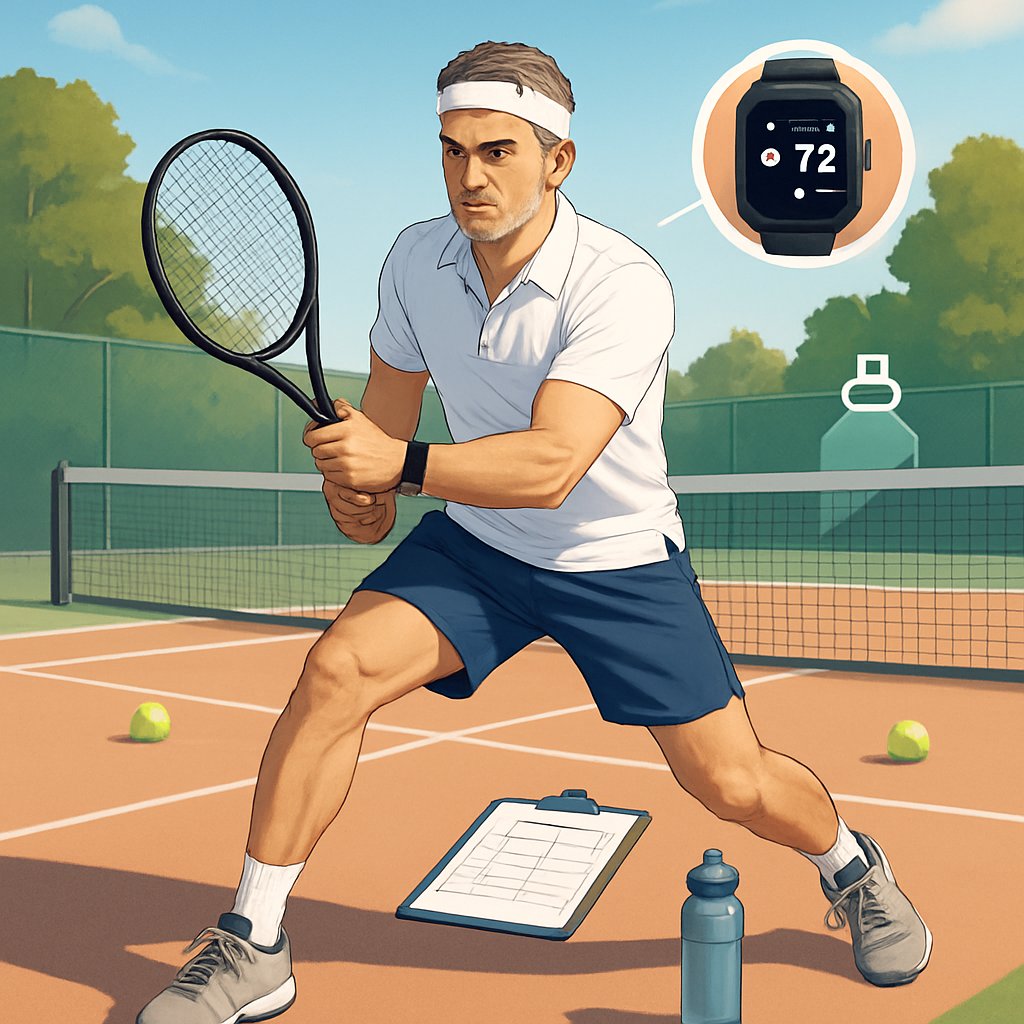
Playing great tennis after 40 means dialing in your training—focus on strength, recovery, and exercises that protect your joints. Your approach to fitness and practice has to change, but your game doesn’t have to slip.
Tennis After 40 requires a focus on joint health and flexibility.
Smart training means really understanding your body now and adjusting your routine for long-term health. You can still build muscle, get faster, and pick up new skills on court.
Adapting your mindset toward Tennis After 40 can enhance your enjoyment of the sport.
The difference? It’s how you set up your training—working with your body, not against it. Pick exercises that actually help your tennis and make recovery a real part of your plan.
Key Takeaways
- Smart training after 40 is all about tennis-specific strength and real recovery, not just endless high-intensity workouts.
- You can still build muscle and improve after 40—just use training methods that fit your age and body.
- Success comes from mixing targeted physical training, on-court strategy, and healthy habits off the court.
Why Training for Tennis Changes After 40
Understanding the nuances of Tennis After 40 can lead to better performance.

After 40, your body changes in ways that really affect how you should train for tennis. Muscle strength, recovery time, and even how you approach competition all shift a bit.
Tennis After 40 means appreciating the changes in your body and adjusting accordingly.
Understanding Age-Related Physical Changes
Muscle mass drops by about 3-8% every decade after 30. That loss speeds up after 40, so your power and endurance take a hit.
Joints get stiffer. Tendons and ligaments aren’t as springy, which makes injuries from quick moves a bigger risk.
Recovery time goes up—a lot. What took 24 hours to bounce back from might now take two or three days.
Bone density starts to dip around 40, so stress fractures and other bone problems can sneak up if you overdo it.
Players need to embrace Tennis After 40 with a focus on longevity and enjoyment.
Your heart and lungs don’t quite have the same zip. Max heart rate drops, and it takes longer to hit your top gear during matches.
How Aging Impacts Tennis Performance
Speed and agility are usually the first to go. It’s tougher to chase down wide balls or recover between points.
Power shots get harder. Serve speed and groundstroke pace often drop as muscle strength fades.
Long matches feel tougher. You might notice you tire out in the final set more than you used to.
Reaction time slows. Fast serves and those quick net exchanges get trickier to handle.
Adapting your strategy in Tennis After 40 can provide a competitive edge.
Because of all this, you have to lean more on strategy and shot placement, not just brute force or speed.
Mindset and Motivation Shifts
Your goals on court start to change. Instead of trying to blast through opponents, you look for smarter positioning and better shot selection.
Injury prevention starts to matter more than winning every single point. You pick your battles more carefully.
Consistency starts to beat flashiness. Steady, low-error tennis can win more matches than going for broke.
Your competitive fire might shift from just winning to enjoying the game longer. Oddly enough, that can actually help you play better.
You get more patient with yourself. Quick fixes aren’t as important as habits that keep you healthy and in the game.
Tennis After 40: Training for Peak Performance
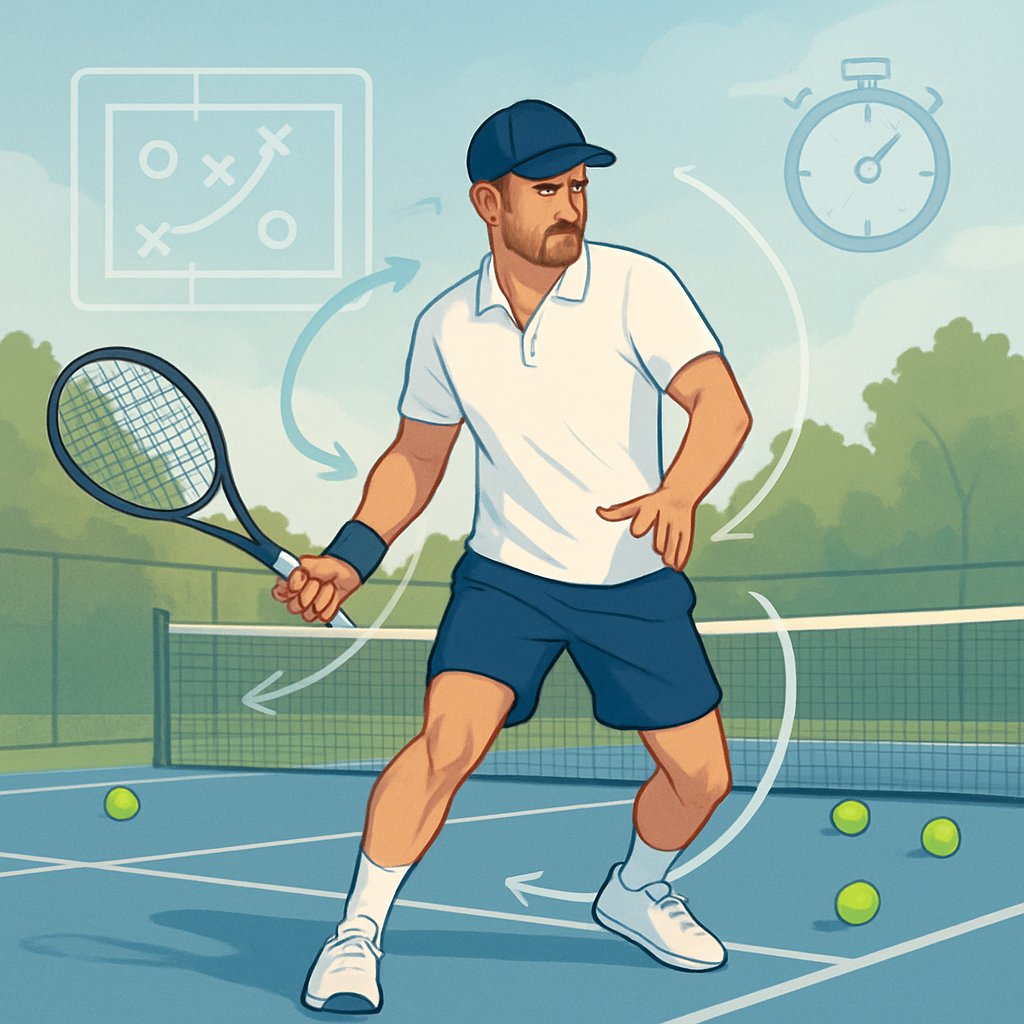
If you’re over 40 and still hitting the courts, your training needs to look different from the younger crowd. Your body takes longer to recover, and the risk of injury goes up if you don’t plan things out.
Incorporating rest is vital in Tennis After 40 to prevent injuries.
Adapting to Slow Recovery
Your body just doesn’t bounce back as quickly after 40. What used to take a day might now take two or three.
Plan for two or three days between hard tennis sessions. On recovery days, do something light—walk, stretch, whatever feels good.
Sleep is huge for recovery. Try for seven to nine hours a night.
Watch for these recovery signals:
-
- Soreness that hangs around more than two days
Monitoring your body in Tennis After 40 helps maintain performance and health.
- Feeling wiped out in warm-ups
- Slow reactions on court
- Stiff joints that don’t loosen up
If you notice these, your body probably needs more rest.
Recovery practices in Tennis After 40 should include hydration and nutrition awareness.
Balancing Intensity and Rest
High-intensity stuff still matters after 40, but you can’t just pile it on. Your heart and lungs don’t respond the same way.
Use the 80/20 rule—spend 80% of your training at a moderate pace and just 20% going all-out. That keeps you from burning out.
Try to alternate hard days and easy days. Don’t stack tough sessions back-to-back.
Sample week:
Tennis After 40 can also benefit from incorporating flexibility routines.
- Monday: Hard drills
- Tuesday: Easy hitting or rest
- Wednesday: Match play
- Thursday: Rest or yoga
- Friday: Moderate session
- Weekend: One match, max
Check your resting heart rate each morning. If it’s up by 10 beats or more, take a rest day.
Being aware of your limits in Tennis After 40 can help you enjoy the game longer.
Progression and Load Management
Ramp up your training slowly. Your tendons and ligaments need more time to adapt than your muscles do.
Add just 10% more volume or intensity each week—maybe that’s a few extra minutes or one new drill.
Work on your technique instead of just trying to hit harder. Good form is more efficient and safer.
Example progression:
- Week 1: 60 minutes
- Week 2: 66 minutes
- Week 3: 72 minutes
Pay attention to joint pain, especially in your knees, shoulders, and elbows. If pain sticks around more than two days, ease up.
Optimized Strength and Conditioning for Tennis Over 40
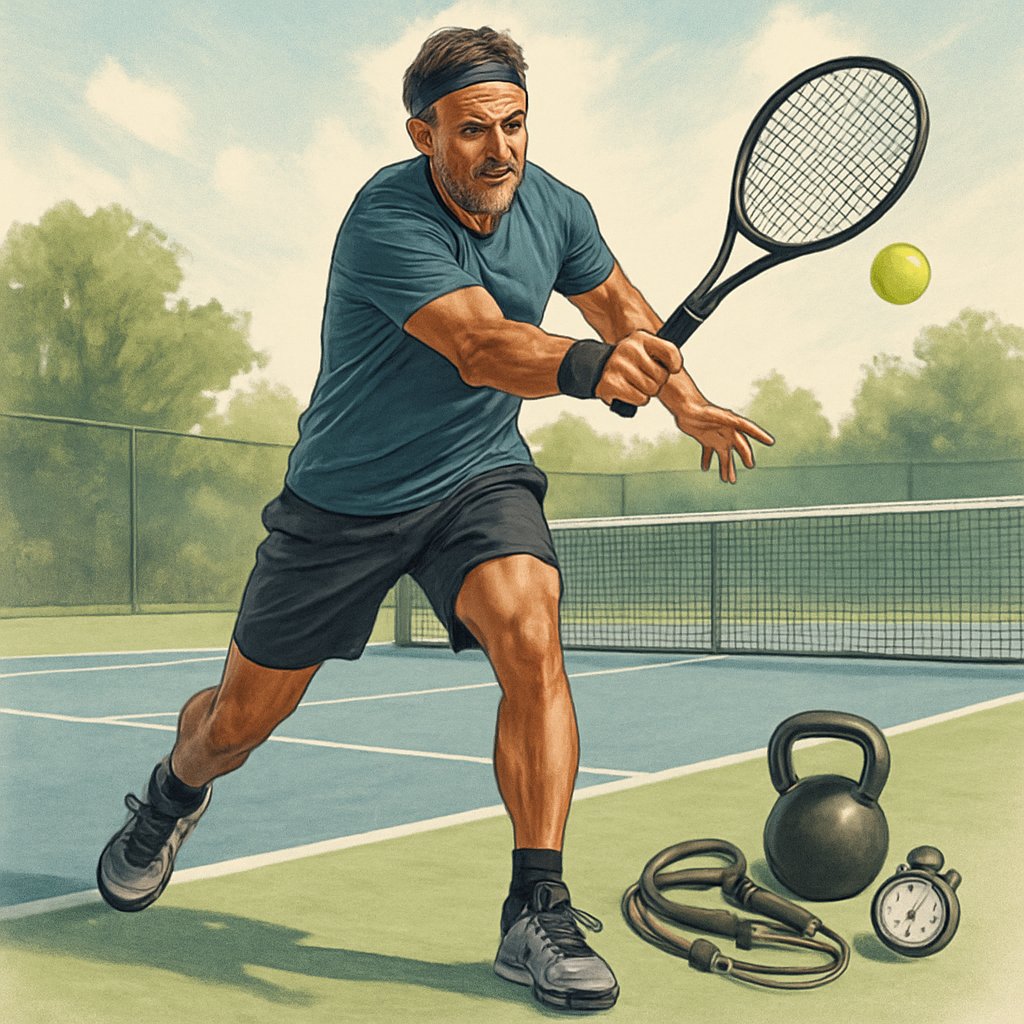
After 40, you need a different training playbook to stay strong and injury-free on the court. Strength training, injury prevention, and mobility work should be your main focus.
Strength Training Importance
After 40, you lose muscle faster—up to 8% a decade. Strength training helps slow that down.
Muscle groups to work on:
-
- Core (for stability and power)
- Rotator cuff (shoulder safety)
- Glutes (movement and injury prevention)
Strength training plays a crucial role in maintaining performance in Tennis After 40.
- Forearms (grip strength)
Choose functional moves. Medicine ball throws and rotational exercises mimic tennis.
HIIT workouts can be great—they build strength and cardio in less time.
How often?
Injury prevention is key for players embracing Tennis After 40.
- Two to three times a week
- 20-40 minutes each session
- Use compound movements
Bodyweight exercises are awesome for home. Push-ups, squats, planks—they all help your tennis game.
Injury Prevention Best Practices
Injury risk jumps after 40, but smart training can help you dodge the most common issues.
Warm-up routine:
Daily stretching routines are important for longevity in Tennis After 40.
- 5-10 minutes light movement
- Dynamic stretches
- Tennis-specific moves
Take at least one rest day between hard sessions. Your body needs the downtime.
Pay attention to your body’s signals. If your joints are stiff or muscles sore, take it easy.
Extra tips:
-
- Use the right grip size
- Replace old shoes often
- Ice sore spots after playing
Warm-up routines should be prioritized for those practicing Tennis After 40.
- Stay hydrated
Cross-training is your friend. Swimming, cycling, yoga—they all give your tennis muscles a break.
Flexibility and Mobility Routines
Stiff muscles and joints can really drag down your game after 40. Daily mobility work keeps you moving better.
Stretches you need:
- Shoulder crossovers
- Hip flexor stretches
- Calf stretches
- Spinal rotations
Hold static stretches for 30-60 seconds after you play, when your muscles are warm.
Do dynamic mobility before you hit the court—arm circles, leg swings, torso twists.
Daily routine:
- Morning: 5-10 minutes of gentle movement
- Pre-tennis: Dynamic warm-up
- Post-tennis: Static stretching
Foam rolling helps too—hit your IT band, calves, and upper back after sessions.
Strategic Tennis Practice and On-Court Techniques
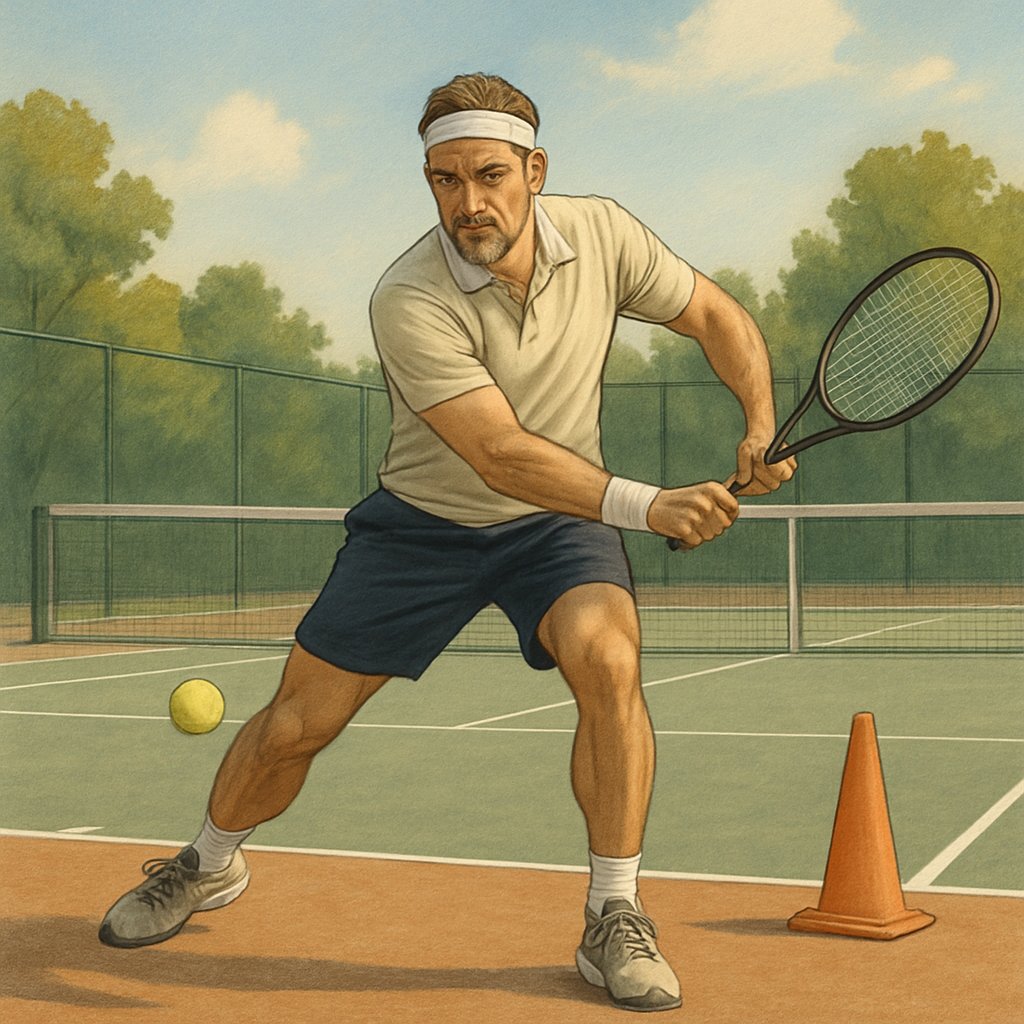
Dynamic warm-ups can enhance performance in Tennis After 40.
The smartest practice focuses on moves that protect your body and sharpen your game. Warm-up routines, smart shot choices, and energy-saving footwork all matter.
Dynamic Warm-Ups and Cool-Downs
Warm-ups are way more important after 40. Start with three to five minutes of light jogging to get your heart going.
Must-do warm-up moves:
-
- Arm circles (both directions)
- Leg swings (front/back, side/side)
- Torso rotations
Energy conservation techniques are essential in Tennis After 40.
- Light shadow swings
Spend a little extra time on your shoulders and hips—they need it.
Cool down after playing to avoid next-day stiffness. Walk the court for five minutes, then stretch your calves, hamstrings, and shoulders.
Hold each stretch for 20-30 seconds, especially in spots that feel tight.
Shot Selection for Longevity
Pick shots that work for your body, not against it. High-percentage shots save your joints and muscles.
Choosing the right shots can make a difference in Tennis After 40.
Smart choices:
- Use more slice backhands (easier on the elbow)
- Go cross-court more than down-the-line
- Focus on placing the ball, not just hitting hard
- Mix in drop shots
Don’t try to blast every ball. Save the big shots for when you really need them.
Practice finishing points quickly. Most rallies end within four shots anyway.
Efficient Footwork and Movement
Good footwork saves energy and helps you avoid injuries. Take smaller, quicker steps instead of big lunges.
Movement tips:
Efficient movement is critical for success in Tennis After 40.
- Stay on the balls of your feet
- Use split steps before your opponent hits
- Recover after each shot
- Move in straight lines when you can
Practice your ready position between points—knees bent, weight forward. It helps you react faster.
Work on your first-step speed. Quick starts matter more than top speed in tennis. Ladder drills and cone work can help.
Lifestyle Factors for Peak Tennis Performance After 40
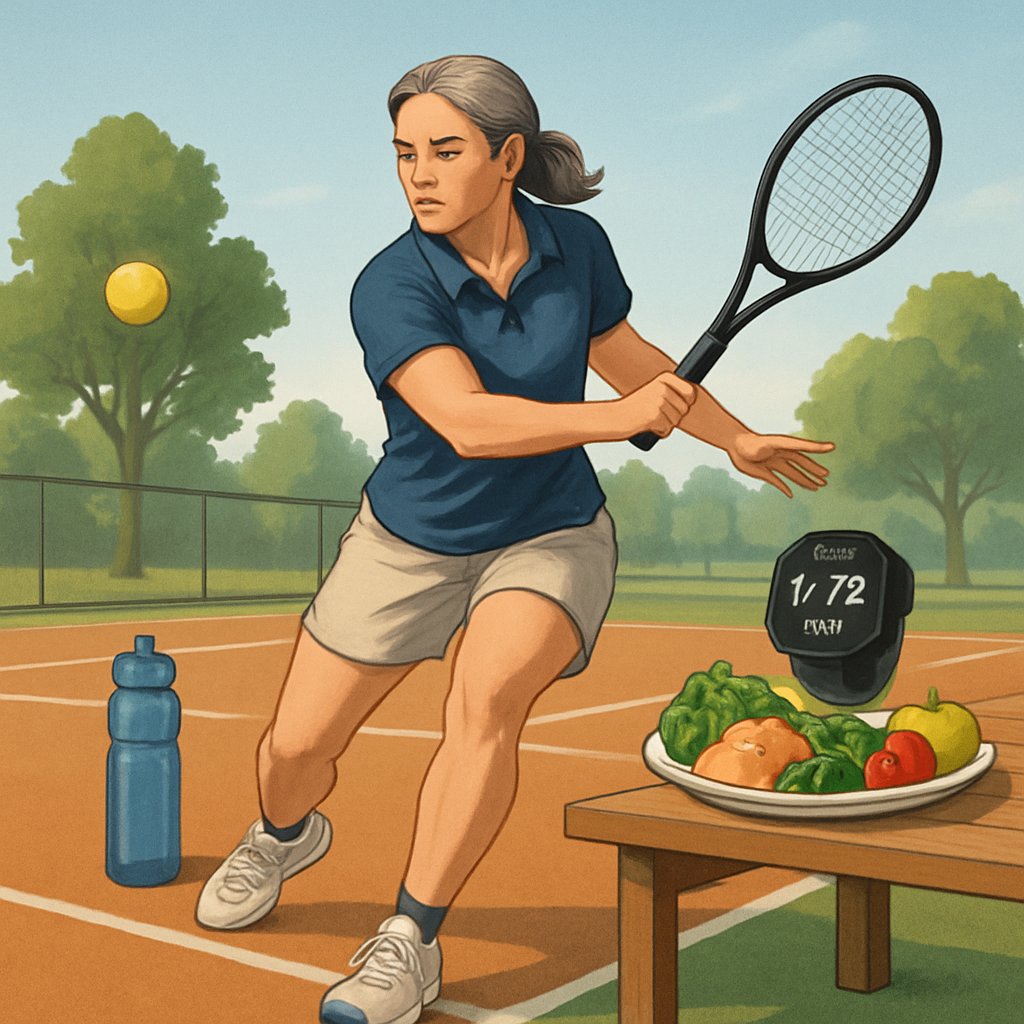
What you do off the court plays a huge role in how you play and recover. Nutrition, sleep, and stress management are bigger deals than ever.
Targeted Nutrition for Athletes Over 40
Nutrition tailored for players is vital in Tennis After 40.
After 40, your body needs more targeted nutrition. Slower metabolism and changing hormones mean you have to be a bit more thoughtful.
Get enough protein to keep your muscles. Shoot for 1.2-1.6 grams per kilogram of body weight each day.
Good protein sources? Lean meats, fish, eggs, beans—take your pick.
Other nutrients to focus on:
- Calcium and Vitamin D (bone health)
- Omega-3s (joint pain and inflammation)
- Antioxidants (muscle recovery)
- B vitamins (energy)
Eat a small snack with carbs and protein within 30 minutes after playing. It helps your muscles bounce back.
Stay hydrated all day, not just during matches. Your body doesn’t hold water as well as it used to.
Sleep and Active Recovery
Sleep is crucial for performance and recovery after 40. Your body just needs more downtime.
Active recovery plays a significant role in performance for Tennis After 40.
Aim for seven to nine hours a night. Bad sleep slows your reaction time and ups injury risk.
Go to bed at the same time every night. Keep your room cool and dark.
Active recovery ideas:
- Light walks or swimming
- Gentle stretching or yoga
- Foam rolling
- Easy bike rides
Take at least one full rest day each week. Your body needs time to rebuild and recover.
Managing Stress and Hormonal Changes
Aging shifts your hormones, and that can mess with your tennis game. Stress just piles on and makes it even tougher to bounce back.
When stress sticks around, cortisol shoots up. That breaks down muscle and makes it easier to gain fat.
Managing stress can improve your game in Tennis After 40.
Staying in tennis shape gets trickier if you ignore stress. It’s not just about the workouts.
Try stress management techniques like deep breathing or meditation. Even ten minutes a day—yeah, just ten—can make a difference.
Hormone changes after 40:
- Lower testosterone and estrogen
- Slower growth hormone production
- Changes in thyroid function
Regular exercise helps your body balance hormones. Tennis keeps you moving and connects you with others, which tends to ease stress.
Regular activity, especially Tennis After 40, helps balance hormones.
If you’re always tired or feel weak, maybe check in with your doctor. Blood tests can spot hormone issues early.
Frequently Asked Questions
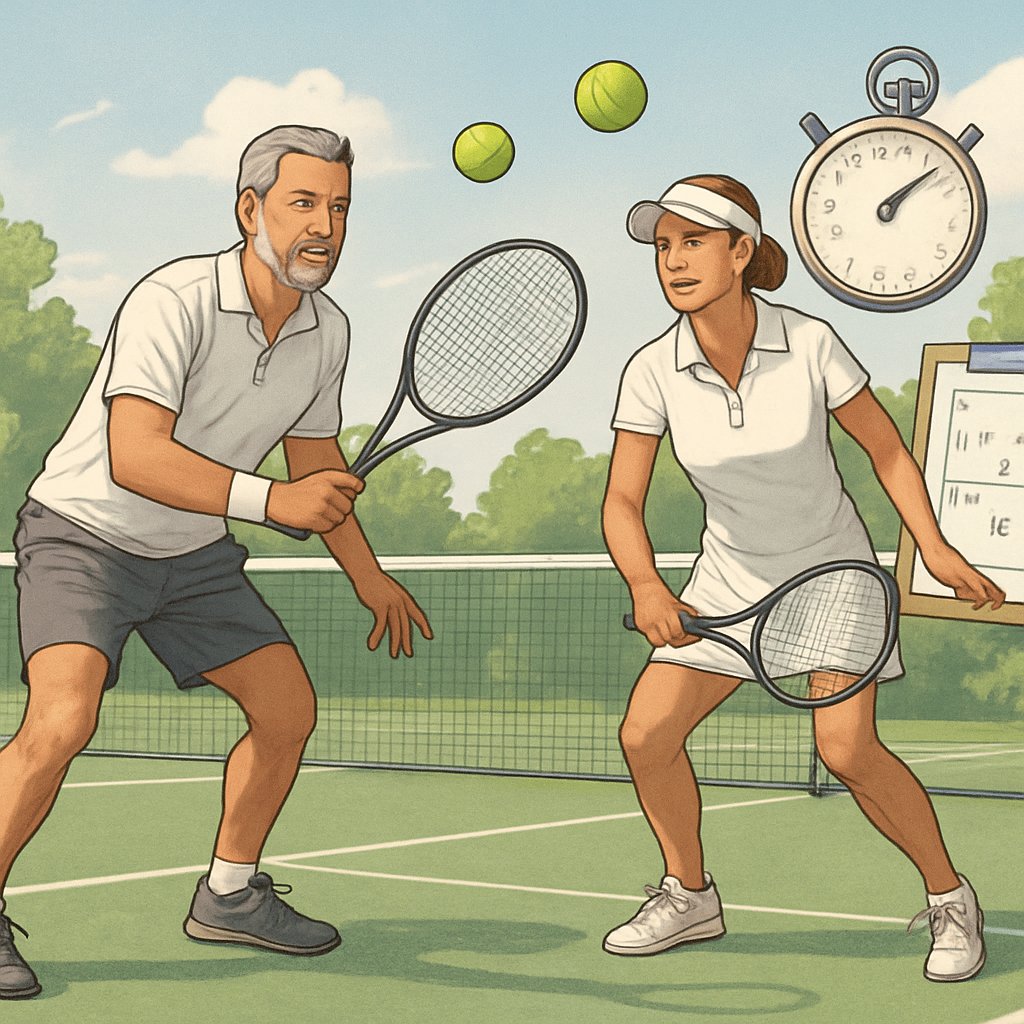
Players over 40 run into unique training challenges. Injury prevention, smarter workouts, and adapting techniques all matter more as you age.
Here are some answers to common questions about training, performance, and staying in the game for the long run.
What are the most effective tennis training programs for players over 40?
The best programs mix strength training, mobility work, and tennis-specific drills. Aim for two or three strength sessions a week with bodyweight moves or light weights.
Stretch and work on mobility every day. This keeps your joints moving and helps you dodge injuries.
When you drill, focus on technique instead of smashing the ball. Practice footwork and movement at a moderate pace.
A focus on recovery becomes more critical in Tennis After 40.
Recovery matters more than ever now. Give yourself rest days between hard sessions.
How can tennis agility training be adapted for those above the age of 40?
Begin with simple movement patterns before you speed things up. Pay attention to good form during ladder and cone drills.
Keep agility workouts short—15 to 20 minutes is enough. Your body needs more time to bounce back.
Mix in balance exercises like single-leg stands or stability ball work. These help you stay steady and move better on court.
Practice changing direction at about 70-80% intensity. Full speed isn’t always worth the risk.
What are the key differences in tennis training for males and females after 40?
Women usually need to focus more on bone density with weight-bearing moves. Men might need extra flexibility and mobility work.
Hormones mess with recovery in different ways. Women may want longer rest at certain times of the month.
Strength training helps everyone, but resistance work is especially good for women to ward off osteoporosis.
Men lose flexibility faster after 40, so stretching daily is a must to keep moving well.
How does one gauge improvement in tennis when starting as an adult?
Pay attention to consistency, not just power. Count how many rallies you keep going in practice.
Watch how you move on court. Are you getting to balls you used to miss?
Keep a simple log of your matches. Note wins, losses, and how your body feels after playing.
Track your technique, too. Filming yourself can show you small improvements you might miss otherwise.
What are the peak performance strategies for tennis players in their 40s?
Picking the right shots matters more than hitting hard. Go for high-percentage plays and skip the risky ones.
Build a solid serve so you can finish points quickly. That saves energy in longer matches.
Work on your mental game with visualization and breathing. Experience gives you an edge here.
Plan your tournament schedule with care. Make sure you have enough time to recover between big matches.
What longevity benefits are associated with playing tennis for mature adults?
Playing Tennis After 40 contributes significantly to mental well-being.
Tennis boosts bone density and lowers your risk of osteoporosis. The running and jumping? They really give your bones a workout.
The social benefits of Tennis After 40 enhance your overall experience.
Playing regularly keeps your hand-eye coordination sharp. Quick reactions on the court can actually make daily life a bit easier as you get older.
Incorporating fun into your training leads to better results in Tennis After 40.
You’ll also get a nice cardiovascular workout, much like going for a run. But honestly, it’s more fun chasing a ball than pounding the pavement.
Remember, Tennis After 40 is about enjoyment and improving your game.
And let’s not forget the social side. Meeting up for a game helps cut down on isolation and can lift your mood. There’s something about friendly competition that just feels good.
So, keep playing, learning, and enjoying Tennis After 40.
